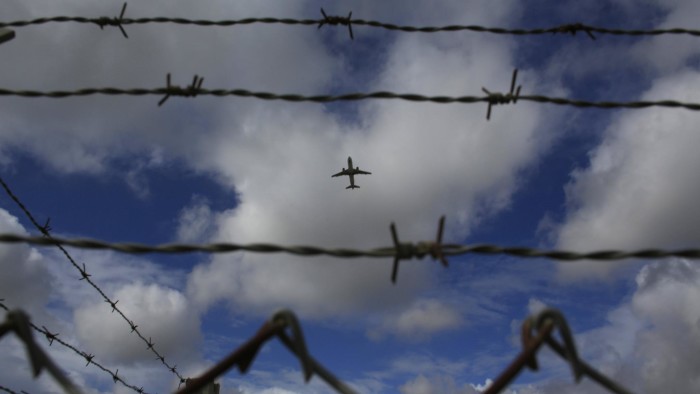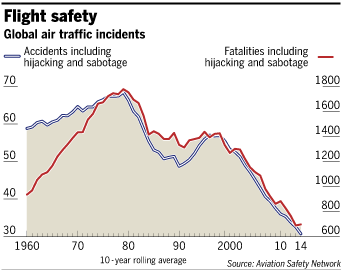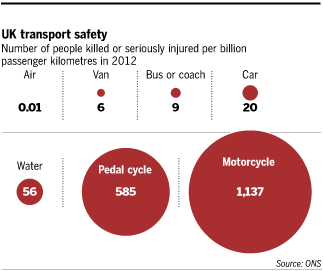Air safety - Flying blind

Simply sign up to the World myFT Digest -- delivered directly to your inbox.
On July 14, Ukrainian officials issued an updated “notice to airmen”. The bulletin instructed commercial pilots to increase their altitude but stopped short of telling them to avoid an area where pro-Russia rebels had began shooting down Ukrainian military aircraft.
The final line read “FM FL260 up to FL320” – technical guidance to increase the minimum height for flights passing over the country’s eastern flank from 26,000ft to 32,000ft.
Three days later, Malaysia Airlines’ Flight MH17 followed the instruction and flew at 33,000 feet en route to Australia from Amsterdam via Kuala Lumpur. By early afternoon, the Boeing 777 went out of contact and crashed, killing all 298 people onboard and sparking international outrage.
While investigations continue, western experts point to overwhelming signs that the flight was struck by an anti-aircraft missile with a range of more than 32,000ft.
The MH17 disaster has “changed everything”, says Sir Tim Clark, president of Emirates Airline, the world’s largest operator of long-haul aircraft, who wants wide-ranging reforms to air space management. “It amounted to premeditated mass murder.”
Whatever the findings of the international inquiries now under way, the crash, along with several other recent air safety incidents, is triggering a fierce round of soul-searching in the aviation world. The loss of MH17 and Malaysia Airlines flight MH370, which disappeared in March over the Indian Ocean with 239 people onboard, has forced the Malaysian government to nationalise the airline.
The MH17 incident has raised broader questions about safety, revealing that the system of policing air space in conflict zones is broken. It has shown how instructions from aviation authorities, information available to airlines and the responses they adopt, vary radically – with lethal implications.
If the downing of MH17 is confirmed as the work of a rebel group, it would be the first case of a passenger jet being destroyed at cruise altitude. Yet some airline executives are not waiting for confirmation of who shot down the aircraft to call for reforms, including allowing airlines to have better access to information from intelligence agencies that could save passengers’ lives.

“Airlines were told that flights above 32,000ft that traverse Ukraine would not be in harm’s way. We now know how wrong that guidance was,” Tony Tyler, director-general of the International Air Transport Association, the airlines’ main representative body, said last month.
For years, airlines flying over conflict zones have had to contend with shoulder-fired missiles with a range of about 10,000ft that can be a real danger when aircraft take off and land.
But MH17 was allegedly shot down with a Russian-made Buk surface-to-air missile with a range of 70,000ft, capable of destroying any aircraft flying at cruise altitudes.
In late June, separatists in Donetsk posted on their Twitter account a picture of a Buk missile launcher and declared that it was in their possession. Western intelligence and boasts posted by rebel leaders on social media websites suggest they were responsible for the July 17 crash.
Several inquiries have since been launched, including a criminal investigation by Dutch prosecutors focused on possible war crimes. An interim report by the Dutch Safety Board into the cause of the MH17 crash is due to be released early next month.
While Ukraine accuses separatists of firing a missile, a charge backed by the US, and Russia says that Kiev was responsible, some experts say the disaster could have been prevented if commercial flights over eastern Ukraine had been banned. Chris Yates, an aviation analyst, says that a complete ban should have been imposed as soon as military aircraft came under threat.
Volodymyr Hroisman, Ukraine’s vice prime minister and head of a government task force investigating MH17, did not respond to questions about the country’s air space management decisions.

The fact that airlines were flying over the Ukraine conflict zone may seem baffling to those outside the airline industry. In the seven days before the tragedy, Malaysia Airlines was among 66 carriers and private jet operators identified over the same area, according to data collected by Flightradar24, an aircraft tracking service. These included Singapore Airlines, Lufthansa, the German carrier, and KLM of the Netherlands.
The eastern Ukraine route was one of the most direct ways of flying between Europe and Asia, helping minimise airlines’ fuel bills, which often constitute their biggest single expense. Aeroflot, the Russian carrier, estimates that avoiding the region will cost it $20m a year in extra fuel, for example. Such sums are considerable for an industry already grappling with wafer-thin profit margins.
In other conflict zones, airlines have also adopted differing policies. Experts say there is no evidence that insurgents from the Islamic State of Iraq and the Levant, known as Isis, who control much of northern and western Iraq, have acquired a high-altitude missile. But several airlines announced last month they would stop flying over Iraq.
Air France suspended routing over the country on July 25, for instance, and Emirates announced plans to follow suit on July 28. These carriers had to make significant changes to their flight paths because Iraq was an important segment on their routes. For Emirates, it was one of the main connections with Europe. In contrast, British Airways, Etihad Airways of Abu Dhabi and Qatar Airways continued to fly over Iraq until August 8 – the day the US began a campaign of military air strikes against Isis, and when the US Federal Aviation Administration banned US carriers from passing over the country.
One problem with policing air space in conflict zones is that decisions about flying are divided between national regulators and airlines themselves. There is very little meaningful international co-ordination, and political and economic factors may weigh on their decisions.
The prime responsibility for air space management lies with the country over which flights pass. A national regulator – usually the civil aviation authority – can restrict aircraft flights. Introducing limitations means the country concerned will lose the money generated from charging airlines for air traffic control guidance over the territory. This raises questions about a possible conflict of interest between a state’s responsibility to keep airlines out of dangerous air space and the wish to maximise revenue from air traffic control charges.
Since the downing of MH17, some regulators have appeared to be putting greater emphasis on passenger safety. But the result is confused. On July 22, the FAA banned US airlines from flying to Ben Gurion International airport in Tel Aviv after a Hamas rocket landed close to the Israeli hub.
Authorities in Israel responded by insisting that it was safe to fly to Ben Gurion, and accused US airlines of handing a “prize to terrorism”. Some airlines continued to fly to Tel Aviv, including BA. Less than 24 hours after imposing its ban, the FAA lifted the prohibition following a review of measures that Israel had taken to safeguard aircraft.
In the absence of a regulatory ban, each airline is left to decide if it will pass over a conflict zone. Carriers make their own risk assessments to determine which countries are safe to fly to or over.
The big airlines have employees dedicated to the task. These companies will often draw upon information provided by their home country government, usually based on material obtained by its intelligence agencies.
Yet smaller airlines are unlikely to have access to such government intelligence. Their routing decisions are also vulnerable to pressures such as the desire to take the most direct routes in order to save fuel. “This risk assessment approach gives an illusion of safety but it is in fact vulnerable to all sorts of influences including commercial pressure,” says the British Airline Pilots Association.
The problem is compounded by the fact that airlines rarely share their risk assessments. Willie Walsh, chief executive of International Airlines Group, the parent of British Airways, said the carrier has never shared the risk analysis that led it to stop flying over eastern Ukraine in March.
Earlier this month, Mr Walsh suggested that if BA had done so with Malaysia Airlines, the disaster might have been avoided. “Would it have made a difference?” he said. “You would like to think that it would.”
One approach that most airlines reject is placing anti-missile technology on their aircraft. Ian King, chief executive of BAE Systems, the UK defence manufacturer, suggested carriers should think about such protection after the MH17 disaster.
But Mr Walsh described Mr King’s comments as “absolutely ridiculous”, adding: “If Ian King has a concern, then . . . stop developing any military equipment.”
Carsten Spohr, chief executive of Lufthansa, reflects a more widely held view that airlines should have greater access to information from governments, and in particular, intelligence agencies. “The key – and this is why it is so difficult – is to use information that is only available to military and government intelligence agencies to safeguard . . . our industry,” he said.
The International Civil Aviation Organisation, the UN agency that sets global aviation standards, held an emergency meeting in late July and has set up a task force to investigate issues raised by the MH17 disaster.
Olumuyiwa Benard Aliu, president of the ICAO council, said that there could be a bigger role for the agency in decisions about whether airlines should fly over conflict zones.
One person familiar with the organisation’s work said a possible reform would be the creation of a body operating under it collected intelligence from multiple sources and shared it with airlines.
These changes sound straightforward but implementation would not be simple. Governments are reluctant to share intelligence, mindful of the risk of compromising their sources. The ICAO has a reputation for being slow to act, partly because it reaches decisions by consensus among its 191 member states. That process has slowed its efforts to tackle airlines’ carbon emissions, for instance.
The organisation’s task force is set to report by the end of October, and it has a safety conference next February that could consider any proposed reforms following the MH17 crash.
In the meantime, voluntary co-operation between airlines may offer the best hope. Emirates is among the carriers hoping it can at least exchange risk assessments with its peers about flights over conflict zones.
Sir Tim points out that one carrier could gain access to critical information about whether it is safe to pass over a conflict zone from their home country government, and this could then be brought to other airlines’ attention. “If that [information] has come from Lufthansa or KLM or British Airways, that is good enough for me,” he adds.
Travel risk: A deadly year for flight, but fatalities are still low
Crashes always put some people off boarding a passenger jet but statistics suggest long-term flight safety trends continue to improve.
Passenger deaths and air accidents have been broadly falling since the early 1970s in spite of surges in certain years, including 2014, according to the Aviation Safety Network, an organisation that tracks crashes and other incidents.
The disappearance of Malaysia Airlines’ flight MH370 on March 8 showed that there is still no robust way of tracking aircraft. In spite of an intensive search of the Indian Ocean off Western Australia, the aircraft has not been found.
In the seven days after the downing of MH17 over eastern Ukraine on July 17, there were crashes involving a TransAsia Airways turboprop aircraft and an Air Algerie jet. More than 160 people died in these incidents, which may have been due to poor weather.
There have been 13 fatal air accidents so far this year involving passenger and cargo aircraft, compared with 29 in 2013. It is principally the loss of MH370 and the downing of MH17 that will ensure 2014 records the highest level of passenger fatalities in five years.
Yet deaths peaked in 1972, when 2,510 people were killed in 75 air accidents. The number of incidents has been falling since even as the use of air travel has increased significantly. There were 30.3m commercial flights in 2012, compared with 9.4m in 1970.
Harro Ranter, president of the Aviation Safety Network, says the number of fatal accidents fell markedly around 2000, once regulators started auditing not just airlines but also aviation oversight agencies.
Ascend, an aviation consultancy, says fatal passenger accidents are occurring at an average of less than one per month today compared with one per week at the start of the commercial jet age.
The global accident rate in 2013 – measured in aircraft losses per million flights involving western-built jets – was the equivalent of one incident for every 2.4m flights, according to the International Air Transport Association. That makes air travel safer than many other forms of transport, notably the car.
Comments